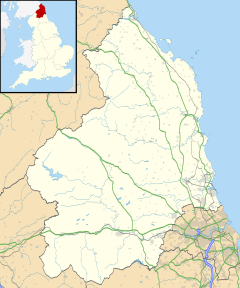Cramlington, Northumberland
| Cramlington | |
|---|---|
 The parish church of St. Nicholas |
|
| Cramlington shown within Northumberland | |
| Population | 44,216 (2017) |
| OS grid reference | NZ270760 |
| Civil parish |
|
| Unitary authority | |
| Ceremonial county | |
| Region | |
| Country | England |
| Sovereign state | United Kingdom |
| Post town | CRAMLINGTON |
| Postcode district | NE23 |
| Dialling code | 01670 |
| Police | Northumbria |
| Fire | Northumberland |
| Ambulance | North East |
| EU Parliament | North East England |
| UK Parliament | |
Cramlington is a town and civil parish in the county of Northumberland, North East England, situated 9 miles (14 kilometres) north of the city of Newcastle upon Tyne. The town's name suggests a probable founding by the Danes or an Anglo-Saxon origin, the word "ton" meaning town. The population was estimated as 39,000 in 2004, measured at 29,413 at the 2011 Census. It sits on the border between Northumberland and North Tyneside with the traffic interchange at Moor Farm, Annitsford (in the latter) linking the two areas.
The village of East Cramlington lies east of the A189, on the B1326 road that connects Cramlington to Seaton Delaval.
The first record of the Manor of Cramlington is from a mention in 1135 when the land was granted to Nicholas de Grenville. A register of early chaplains begins with John the Clerk of Cramlington (c. 1163–1180). The register continues to the present day.
From the 12th century onwards, its history has been mostly rural, incorporating several farms and the parish church of St. Nicholas (built at a cost of £3,000 during 1865–1868 in the Gothic style). During the early 19th century, coal mining with several mine shafts in the immediate vicinity began to change that. In 1813 Collingwood Main Colliery suffered an explosion of firedamp in which 8 people were killed. Six miners were carrying timber through the "old workings" when their candles set fire to firedamp. The resulting afterdamp and chokedamp resulted in a wider loss of life to men and horses.
...
Wikipedia

